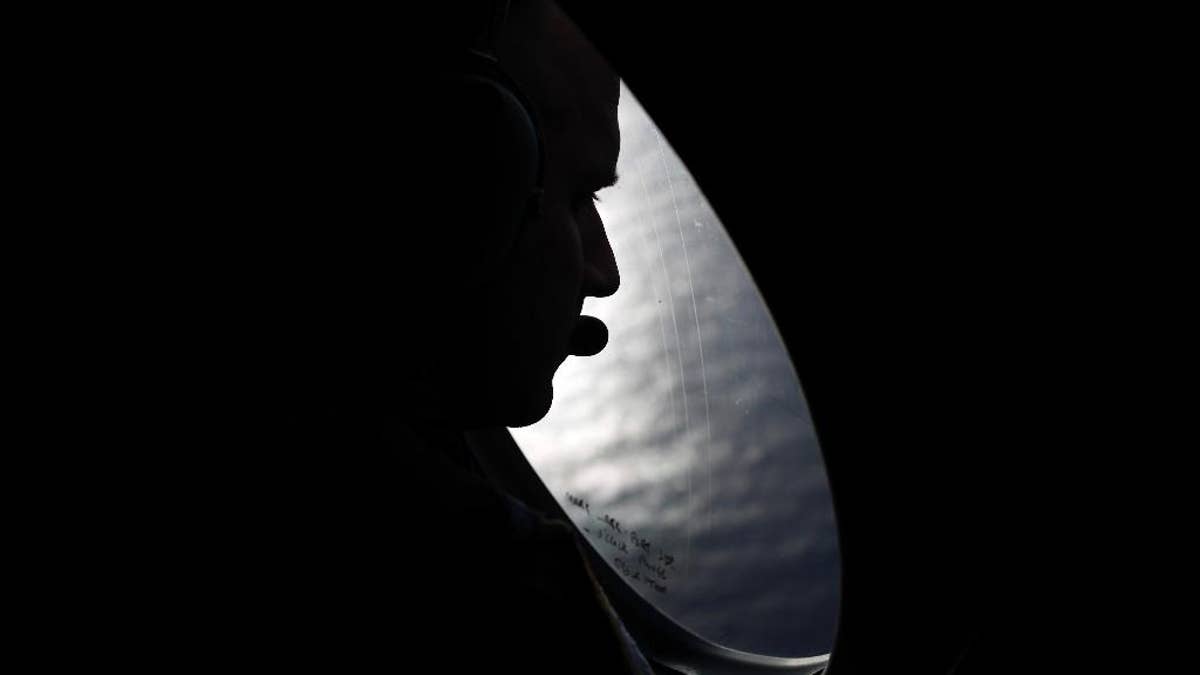
A Royal New Zealand Air Force crew member looks into the southern Indian Ocean from a P-3K2 Orion aircraft searches for missing Malaysian Airlines flight 370, Saturday, March 29, 2014. A day after the search for the Malaysian jetliner shifted to a new area of the Indian Ocean, ships on Saturday plucked objects from the sea to determine whether they were related to the missing jet. None were confirmed to be from the plane, leaving searchers with no sign of the jet three weeks after it disappeared. (AP Photo/Jason Reed, Pool) (The Associated Press)
PERTH, Australia – Australia's prime minister said Sunday he was hopeful a clue will emerge soon to narrow the hunt for Flight 370, as more objects are pulled from the southern Indian Ocean and checked to see if they are part of the plane that went missing more than three weeks ago.
But so far, even though more ships are scouring the area off western Australia, none of the recovered items has been connected to the Malaysia Airlines plane that crashed March 8 with 239 people on board.
"My understanding from this morning is that there has been no discrete debris associated with the flight," Australian Navy Commodore Peter Leavy told reporters Sunday.
In Sydney, Australian Prime Minister Tony Abbott described the "intensifying search effort" as positive because objects "have been recovered from the ocean."
The Australian Maritimes Safety Authority said 10 planes took part in the search Sunday, leaving in staggered times from the western city of Perth. Eight ships were on the scene, including the Australian navy supply ship HMAS Success, which is to store any wreckage found.
The ships are trying to locate and identify the objects sighted by aircraft over the past two days.
Leavy, the commander of the search task force, said the operation was made more difficult because the particular area being combed is in a shipping lane littered with potentially more floating objects.
AMSA said there were light showers and low cloud in the area, but not enough to disrupt the search, which is about 2 ½ hours flying time from Perth, allowing the planes five hours of searching time before they have to return to base.
Among the objects spotted over the last day were three by a Chinese Ilyushin IL-76 plane that were white, red and orange, according to a report from China's official Xinhua News Agency said. The missing Boeing 777's exterior was red, white, blue and gray.
In Kuala Lumpur, several dozen Chinese relatives of passengers on Flight 370 arrived Sunday to demand to meet top officials for more information about what happened to the airliner.
Two-thirds of the 227 passengers aboard the plane en route to Beijing from Kuala Lumpur were Chinese, and Beijing has urged Malaysia to be more open about the investigation.
One of the relatives, who gave only his surname, Xu, said that the relatives want to meet officials "at the very highest levels."
Newly analyzed satellite data shifted the search zone on Friday, raising expectations that searchers may be closer to getting physical evidence that the plane crashed into the Indian Ocean. The change came after analysts determined that the Boeing 777 may have been traveling faster than earlier estimates and would therefore have run out of fuel sooner.
That would narrow the hunt for the wreckage and the plane's black boxes, which should contain clues to what caused the plane to be so far off-course.
An Australian warship with an aircraft black box detector was set to depart Sunday to join the search. It will still take three to four days for the ship, the Ocean Shield, to reach the search zone — an area roughly the size of Poland about 1,850 kilometers (1,150 miles) to the west of Australia.
"The ship will take part in the surface search until the debris is positively identified and an underwater search area is then predicted," U.S .Navy Captain Mark Matthews told reporters in Perth.
The Ocean Shield will be equipped with a black box detector — the U.S. Navy's Towed Pinger Locator — and an unmanned underwater vehicle, as well as other acoustic detection equipment.
But even if investigators can determine that the plane went down in the newly targeted search zone, recovery of its flight data and cockpit voice recorders could be complicated.
The sea floor within the search area is covered in squishy sediment and generally flat, save for a steep slope and trench near its southern end.
Unless the plane's fuselage went down the slope or into the trench, the underwater geography should not hinder the search. The area is dominated by Broken Ridge, a plateau where depths range from as shallow as about 800 meters (2,625 feet) to about 3,000 meters (9,843 feet). At the edge of the plateau closest to Antarctica is the Diamantina trench, which sea floor mappers have found is as deep as 5,800 meters (19,000 feet), though it could be deeper in places that have not been measured.
Matthews said the Navy's ping locator has the "capability to do search and recovery operations down to a depth of 20,000 feet."
Data on the black boxes may help investigators solve what has become one of aviation's big mysteries — what happened to Flight 370, with speculation ranging from equipment failure and a botched hijacking to terrorism or an act by one of the pilots.
Abbott also announced that former Australian defense chief, Air Chief Marshal Angus Houston, will lead a new center in Perth to coordinate the international search effort.
___
Wong reported from Kuala Lumpur. Associated Press writers Scott McDonald and Eileen Ng in Kuala Lumpur; Kristen Gelineau in Sydney; Rod McGuirk in Canberra, Australia; Nick Perry in Wellington, New Zealand; Aritz Parra and Didi Tang in Beijing, and Justin Pritchard in Los Angeles, contributed to this report.
